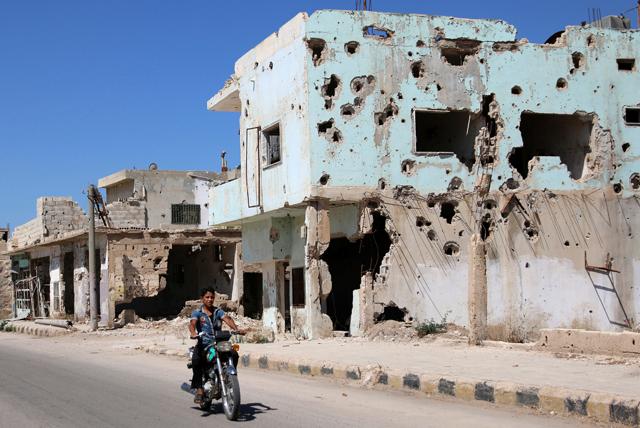You are here
Syrian gov’t forces used chemical weapons more than 2 dozen times — UN
By Reuters - Sep 06,2017 - Last updated at Sep 06,2017

Syrians burry the body of a victim in the rebel-held town of Masraba, east of Douma in eastern Ghouta, following reported shelling by government forces on Tuesday (AFP photo)
GENEVA — Government forces have used chemical weapons more than two dozen times during Syria's civil war, including in April's deadly attack on Khan Sheikhoun, UN war crimes investigators said on Wednesday.
A government warplane dropped sarin on the town in Idlib province, killing more than 80 civilians, the UN Commission of Inquiry on Syria said, in the most conclusive findings to date from investigations into that chemical weapon attack.
The panel also said US air strikes on a mosque in Al Jina in rural Aleppo in March that killed 38 people, including children, failed to take precautions in violation of international law, but did not constitute a war crime.
The weapons used on Khan Sheikhoun were previously identified as containing sarin, an odourless nerve agent. But that conclusion, reached by a fact-finding mission of the Organisation for the Prohibition of Chemical Weapons (OPCW), did not say who was responsible.
"Government forces continued the pattern of using chemical weapons against civilians in opposition-held areas. In the gravest incident, the Syrian air force used sarin in Khan Sheikhoun, Idlib, killing dozens, the majority of whom were women and children," the UN report said, declaring the attack a war crime.
Commission Chairman Paulo Pinheiro told a news conference: "Not having access did not prevent us from establishing facts or reasonable grounds to believe what happened during the attack and establishing who is responsible."
In their 14th report since 2011, UN investigators said they had in all documented 33 chemical weapon attacks to date.
Twenty-seven were by the government of President Bashar Assad, including seven between March 1 to July 7. Perpetrators had not been identified yet in six attacks, they said.
The Assad government has repeatedly denied using chemical weapons. It said its strikes in Khan Sheikhoun hit a weapons depot belonging to rebel forces, a claim "excluded" by Pinheiro.
That attack led US President Donald Trump to launch the first US air strikes on a Syrian airbase.
A separate joint inquiry by the United Nations and OPCW aims to report by October on who was to blame for Khan Sheikhoun.
The UN investigators interviewed 43 witnesses, victims, and first responders linked to the attack. Satellite imagery, photos of bomb remnants and early warning reports were used.
'Gravely concerned' about coalition strikes
The independent investigators said they were gravely concerned about the impact of international coalition strikes on civilians.
"We continue to investigate coalition air strikes carried out to expel ISIS [the Daesh group] from Raqqa resulting in an increasing number of civilian casualties," Pinheiro said.
The report said: "In Al Jina, Aleppo, forces of the United States of America failed to take all feasible precautions to protect civilians and civilian objects when attacking a mosque, in violation of international humanitarian law."
A US military investigator said in June the air strike was a valid and legal attack on a meeting of Al Qaeda fighters.
"However, the commission however has not found any evidence that such an Al Qaeda meeting was taking place," Pinheiro said.
The American F-15s hit the building adjacent to the prayer hall with 10 bombs, followed by a Reaper drone that fired two Hellfire missiles at people fleeing, the UN report said.
"Most of the residents of Al Jina, relatives of victims and first responders interviewed by the commission stated that on the evening in question, a religious gathering was being hosted in the mosque's service building. This was a regular occurrence."
Related Articles
BEIRUT — The Syrian government has denied a UN report accusing it of a sarin attack in April that killed scores of people, state media said
THE HAGUE — The Syrian government’s chemical weapons stockpile has been linked for the first time by laboratory tests to the largest s
THE HAGUE — The global chemical arms watchdog Thursday "overwhelmingly" rejected a Russian-Iranian move to launch a new investigation into a

















